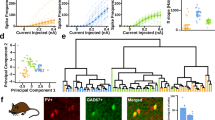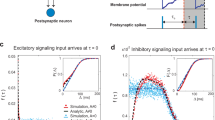Abstract
The neocortex has at least two different networks of electrically coupled inhibitory interneurons: fast-spiking (FS) and low-threshold-spiking (LTS) cells. Agonists of metabotropic glutamate or acetylcholine receptors induced synchronized spiking and membrane fluctuations, with irregular or rhythmic patterns, in networks of LTS cells. LTS activity was closely correlated with inhibitory postsynaptic potentials in neighboring FS interneurons and excitatory neurons. Synchronized LTS activity required electrical synapses, but not fast chemical synapses. Tetanic stimulation of local circuitry induced effects similar to those of metabotropic agonists. We conclude that an electrically coupled network of LTS interneurons can mediate synchronized inhibition when activated by modulatory neurotransmitters.
This is a preview of subscription content, access via your institution
Access options
Subscribe to this journal
Receive 12 print issues and online access
$209.00 per year
only $17.42 per issue
Buy this article
- Purchase on Springer Link
- Instant access to full article PDF
Prices may be subject to local taxes which are calculated during checkout







Similar content being viewed by others
References
Holt, G. R., Softky, W. R., Koch, C. & Douglas, R. J. Comparison of discharge variability in vitro and in vivo in cat visual cortex neurons . J. Neurophysiol. 75, 1806– 1814 (1996).
Gray, C. M. The temporal correlation hypothesis of visual feature integration: still alive and well. Neuron 24, 31– 47 (1999).
deCharms, R. C. & Merzenich, M. M. Primary cortical representation of sounds by the coordination of action-potential timing. Nature 381, 610–613 (1996).
Donoghue, J. P., Sanes, J. N., Hatsopoulos, N. G. & Gaal, G. Neural discharge and local field potential oscillations in primate motor cortex during voluntary movements. J. Neurophysiol. 79, 159–173 (1998).
Azouz, R. & Gray, C. M. Cellular mechanisms contributing to response variability of cortical neurons in vivo. J. Neurosci. 19, 2209–2223 (1999).
Stevens, C. F. & Zador, A. M. Input synchrony and the irregular firing of cortical neurons. Nat. Neurosci. 1, 210–217 (1998).
Lampl, I., Reichova, I. & Ferster, D. Synchronous membrane potential fluctuations in neurons of the cat visual cortex. Neuron 22, 361 –374 (1999).
Steriade, M. Synchronized activities of coupled oscillators in the cerebral cortex and thalamus at different levels of vigilance. Cereb. Cortex 7, 583–604 (1997).
Fisahn, A., Pike, F. G., Buhl, E. H. & Paulsen, O. Cholinergic induction of network oscillations at 40 Hz in the hippocampus in vitro. Nature 394, 186–189 (1998).
Buzsaki, G. & Chrobak, J. J. Temporal structure in spatially organized neuronal ensembles: a role for interneuronal networks. Curr. Opin. Neurobiol. 5, 504–510 (1995).
Benardo, L. S. Recruitment of GABAergic inhibition and synchronization of inhibitory interneurons in rat neocortex. J. Neurophysiol. 77, 3134 –3144 (1997).
Zhang, Y. et al. Slow oscillations (≤1 Hz) mediated by GABAergic interneuronal networks in rat hippocampus. J. Neurosci. 18, 9256–9268 (1998).
Whittington, M. A., Traub, R. D. & Jefferys, J. G. Synchronized oscillations in interneuron networks driven by metabotropic glutamate receptor activation. Nature 373, 612–615 (1995).
Traub, R. D., Jefferys, J. G. R. & Whittington, M. A. Fast Oscillations in Cortical Circuits (MIT Press, Cambridge, Massachusetts, 1999).
Skinner, F. K., Zhang, L., Velazquez, J. L. & Carlen, P. L. Bursting in inhibitory interneuronal networks: A role for gap-junctional coupling . J. Neurophysiol. 81, 1274– 1283 (1999).
Kawaguchi, Y. & Kubota, Y. GABAergic cell subtypes and their synaptic connections in rat frontal cortex. Cereb. Cortex. 7, 476–486 (1997).
Somogyi, P., Tamas, G., Lujan, R. & Buhl, E. H. Salient features of synaptic organisation in the cerebral cortex. Brain Res. Rev. 26, 113–135 (1998).
Gibson, J. R., Beierlein, M. & Connors, B. W. Two networks of electrically coupled inhibitory neurons in neocortex. Nature, 402, 75– 79 (1999).
Galarreta, M. & Hestrin, S. A network of fast-spiking cells in the neocortex connected by electrical synapses. Nature 402, 72–75 (1999).
Tamás, G., Buhl, E. H., Lörincz, A. & Somogyi, P. Proximally targeted GABAergic synapses and gap junctions synchronize cortical interneurons. Nat. Neurosci. 3, 366– 371 (2000).
Thomson, A. M. Activity-dependent properties of synaptic transmission at two classes of connections made by rat neocortical pyramidal axons in vitro. J. Physiol (Lond.) 502, 131–147 (1997).
Reyes, A. et al. Target-cell-specific facilitation and depression in neocortical circuits. Nat. Neurosci. 1, 279– 285 (1998).
Kawaguchi, Y. Selective cholinergic modulation of cortical GABAergic cell subtypes. J. Neurophysiol. 78, 1743–1747 (1997).
Kawaguchi, Y. & Shindou, T. Noradrenergic excitation and inhibition of GABAergic cell types in rat frontal cortex. J. Neurosci. 18, 6963–6976 (1998).
Xiang, Z., Huguenard, J. R. & Prince, D. A. Cholinergic switching within neocortical inhibitory networks. Science 281, 985– 988 (1998).
Baude, A. et al. The metabotropic glutamate receptor (mGluR1 alpha) is concentrated at perisynaptic membrane of neuronal subpopulations as detected by immunogold reaction. Neuron 11, 771– 787 (1993).
Schoepp, D. D. & Conn, P. J. Metabotropic glutamate receptors in brain function and pathology. Trends Pharmacol. Sci. 14, 13–20 (1993).
Flint, A. C., Dammerman, R. S. & Kriegstein, A. R. Endogenous activation of metabotropic glutamate receptors in neocortical development causes neuronal calcium oscillations. Proc. Natl. Acad. Sci. USA 96, 12144– 12149 (1999).
Yuste, R., Peinado, A. & Katz, L. C. Neuronal domains in developing neocortex. Science 257, 665–669 (1992).
Kandler, K. & Katz, L. C. Coordination of neuronal activity in developing visual cortex by gap junction-mediated biochemical communication . J. Neurosci. 18, 1419– 1427 (1998).
Wang, X. J. & Rinzel, J. Spindle rhythmicity in the reticularis thalami nucleus: synchronization among mutually inhibitory neurons. Neuroscience 53, 899–904 (1993).
Van Vreeswijk, C., Abbott, L. F. & Ermentrout, G. B. When inhibition not excitation synchronizes neural firing. J. Comput. Neurosci. 1, 313– 321 (1994).
Buhl, E. H., Tamas, G. & Fisahn, A. Cholinergic activation and tonic excitation induce persistent gamma oscillations in mouse somatosensory cortex in vitro. J. Physiol. (Lond.) 513, 117–126 (1998).
Bennett, M. V. Gap junctions as electrical synapses. J. Neurocytol. 26, 349–366 (1997).
Manor, Y., Rinzel, J., Segev, I. & Yarom, Y. Low-amplitude oscillations in the inferior olive: a model based on electrical coupling of neurons with heterogeneous channel densities. J. Neurophysiol. 77 , 2736–2752 (1997).
Michelson, H. B. & Wong, R. K. Synchronization of inhibitory neurones in the guinea-pig hippocampus in vitro. J. Physiol. (Lond.) 477, 35–45 (1994).
Lytton, W. W. & Sejnowski, T. J. Simulations of cortical pyramidal neurons synchronized by inhibitory interneurons. J. Neurophysiol. 66, 1059–1079 (1991).
Cobb, S. R., Buhl, E. H., Halasy, K., Paulsen, O. & Somogyi, P. Synchronization of neuronal activity in hippocampus by individual GABAergic interneurons. Nature 378, 75–78 (1995).
Engel, A. K., Roelfsema, P. R., Fries, P., Brecht, M. & Singer, W. Role of the temporal domain for response selection and perceptual binding. Cereb. Cortex 7, 571–582 (1997).
Hatsopoulos, N. G., Ojakangas, C. L., Paninski, L. & Donoghue, J. P. Information about movement direction obtained from synchronous activity of motor cortical neurons. Proc. Natl. Acad. Sci. USA 95, 15706–15711 (1998).
Mainen, Z. F. & Sejnowski, T. J. Reliability of spike timing in neocortical neurons. Science 268, 1503 –1506 (1995).
Häusser, M. & Clark, B. A. Tonic synaptic inhibition modulates neuronal output pattern and spatiotemporal synaptic integration . Neuron 19, 665–678 (1997).
Agmon, A. & Connors, B. W. Thalamocortical responses of mouse somatosensory (barrel) cortex in vitro. Neuroscience 41, 365–379 (1991).
Acknowledgements
We thank Yael Amitai and Michael Paradiso for comments and Saundra Patrick for technical assistance. This work was supported by a fellowship to M.B. from the Burroughs-Wellcome Trust, a fellowship to J.R.G. from NIH (NS10478) and grants to B.W.C. from NIH (NS25983 and DA12500).
Author information
Authors and Affiliations
Corresponding author
Rights and permissions
About this article
Cite this article
Beierlein, M., Gibson, J. & Connors, B. A network of electrically coupled interneurons drives synchronized inhibition in neocortex. Nat Neurosci 3, 904–910 (2000). https://doi.org/10.1038/78809
Received:
Accepted:
Issue Date:
DOI: https://doi.org/10.1038/78809
This article is cited by
-
Evolutionarily conservative and non-conservative regulatory networks during primate interneuron development revealed by single-cell RNA and ATAC sequencing
Cell Research (2022)
-
Diversity of neuronal activity is provided by hybrid synapses
Nonlinear Dynamics (2021)
-
Effects of Neuromodulation on Excitatory–Inhibitory Neural Network Dynamics Depend on Network Connectivity Structure
Journal of Nonlinear Science (2020)
-
A Combined Offline–Online Algorithm for Hodgkin–Huxley Neural Networks
Journal of Scientific Computing (2020)
-
A computational investigation of electrotonic coupling between pyramidal cells in the cortex
Journal of Computational Neuroscience (2020)



